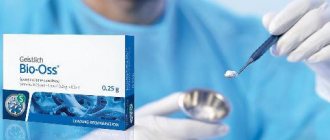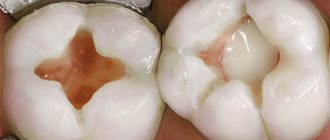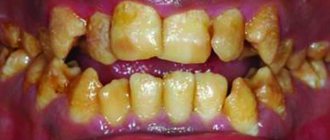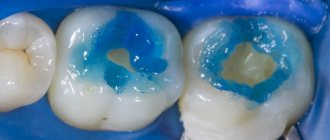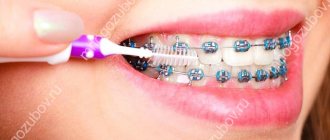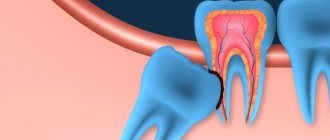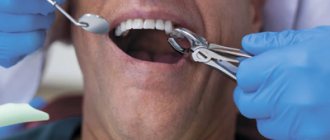861
The use of compomer materials in dental practice makes it possible to eliminate dental defects not only in adult patients, but also in children.
At the same time, a high level of aesthetic indicator is noted. The manufactured fillings are also distinguished by the feature of not losing their natural color for a long time.
Overview characteristics
Compomers get their name from the combination of restorative materials such as composites and glass ionomers.
This type of material is polymerized through double curing. Initially, methacrylate resins are activated under the influence of ultraviolet rays. Subsequently, under the influence of oral fluid, glass ionomer components are bound directly inside the filling.
It is important to know! During the second stage of curing, the installed filling can increase in volume by up to 3%. This compensates for the process of possible shrinkage of the material.
Initially, it was assumed that the combination of composite materials and glass ionomer cements would absorb the best positive qualities of these compounds. But, as practice has shown, these expectations were not met. Therefore, to ensure high strength, glaciosites are used in tandem with adhesives.
Types of cements
Dental cements and other filling compounds are used in the treatment of permanent and primary teeth in the form of fillings, linings, obturation materials and sealants.
They are classified according to their basis, and can be of the following types:
- Mineral cements. They are made on the basis of phosphoric acid, which is why they are called “phosphates”. These include zinc phosphate, silicate and silicophosphate compounds.
- Polymer cements. They use organic acid as a base, usually polyacrylic acid. This group includes polycarboxylate and glass ionomer cements.
- Oil-based formulations. The main material of this group is zinc oxide-eugenol cement.
- Water-based materials (water-based dentin).
Phosphates
Phosphates in pediatric dentistry are used as a permanent filling material or to form insulating linings.
The powder consists of 70-90% zinc oxide. It requires liquid to mix it.
The mixture hardens in 3-9 minutes at room temperature, but this time can be increased if you use a cooled plate when kneading.
The substance has the following advantages:
- fast hardening;
- good strength characteristics;
- plastic;
- low level of shrinkage.
However, such a substance has low aesthetic appeal, wears off quickly and can break, and irritates the pulp. The product does not provide an antibacterial effect, although many manufacturers have begun to add silver to the composition.
Phenolates
Zinc oxide eugenol cement is produced in the form of a white powder containing oxides of magnesium and zinc.
To mix the solution, a liquid containing eugenol with cottonseed oil (or olive) is required. Depending on the type of material, it takes 5 minutes or about 24 hours to harden.
The advantages are:
- acceptable level of acidity (pH 6.6-8.0);
- no impact on the pulp;
- antiseptic and bactericidal properties;
- slight anesthetic effect;
- good ductility and ease of use;
- radiopacity.
Disadvantages include solubility under the influence of saliva, insufficient mechanical strength, and the ability to disrupt the polymerization of composites, therefore it is not used as a base.
Polycarboxylates
Polycarboxylate cement is a powder containing calcium salts, magnesium and zinc oxide. It also sometimes contains colored pigments.
The substance is used for filling both temporary and permanent teeth. The main characteristic is good adhesion to enamel and dentin.
At room temperature, the mixture hardens in 2-3 minutes, at 37 degrees this time increases to 6-9 minutes.
The product has the following advantages:
- high adhesion to dentin and tooth enamel;
- practically does not irritate the pulp;
- complete biological compatibility with tissues;
- antibacterial effect;
- radiopacity.
However, this product has disadvantages. It is not durable enough, there are difficulties in use due to the short working time. Aesthetic unattractiveness and the presence of shrinkage are also noted.
There is also difficulty in removing excess cement. If the procedure is carried out too late, the composition will be difficult to separate from the enamel. Cleaning too early will damage the edge seal.
Acrylates
Such cement compositions are two-component. They are presented in the form of liquid and powder, two pastes. The powder contains quartz or borosilicate glass.
The mass hardens in 6-7 minutes, and the total working time is 10-11 minutes. This cement is characterized by high strength and resistance to the oral environment.
However, it is difficult to work with; the material irritates the pulp. Excess is difficult to remove.
Composites
The most common materials for filling teeth are light-curing composites. They freeze under the influence of light of the appropriate frequency. In appearance they are most compatible with the shade and structure of tooth enamel. They are distinguished by excellent strength, can be polished well and are almost invisible on the teeth. Due to their high height, these fillings are ideal for installation on the front teeth.
Plastic materials
Chemically cured plastics are used as filling materials. Such fillings harden fairly quickly, do not cause irritation to the oral cavity, and are resistant to chemical reagents.
Carbondent, acrylic oxide or polymethylsiloxane are used for manufacturing. The materials are resistant to abrasion, but due to subsidence, chemical toxicity and changes in the original shade in dentistry, plastic is used mainly for installing temporary fillings.
Metal fillings
To create metal fillings, alloys based on copper, silver, mercury and other metals are used. Since such materials do not serve an aesthetic function, dentists usually use them when filling molars. They are highly wear-resistant and affordable.
Almagams
Inexpensive and durable, almagam material consists of zinc, tin, silver and mercury, which gives it a dark color. Most often, almagama is used as a filling to treat chewing teeth. Advantages include durability, ductility, ease of installation and low cost. Disadvantages - unsightly appearance, long hardening, release of mercury vapor, increased thermal conductivity and shrinkage of the material.
Gold alloy
Fillings made from precious metals or their analogues are not particularly popular in dentistry. Most patients today prefer naturalness and authenticity. If the patient chooses a gold alloy as a filling material, then you should pay attention to some features: durability, excellent strength, but rather high cost.
Compomers
Good restoration materials for making fillings are compomers - composite-ionomer compositions. Compomers perfectly combine the best qualities of glass ionomers and composites, which provides the material with excellent chemical adhesion, biocompatibility, ease of installation, preservation of the original color and aesthetics.
This is interesting: Icon (Icon) - treatment of caries using the infiltration method
Due to the low release of fluoride and insufficient strength, filling teeth with compomers is advisable in cases where it is necessary to achieve maximum aesthetics.
Classification and main components
The chemical composition of compomer materials includes:
- two types of acid (composite and polyacrylic);
- strontium fluorosilicon glass;
- strontium fluoride compounds;
- stabilizers giving the necessary consistency;
- substances that initiate the polymerization process.
Depending on the area of application of these restoration materials, they are either packable or fluid.
Packable
Allowed for use when the elimination of carious cavities does not occur on the frontal incisors of the front row due to the low level of aesthetic value.
The material is mainly used when installing fillings on molars or premolars, but only in that part of the tooth that experiences minimal pressure during the chewing process.
All materials in this group are characterized by high density and are highly filled. According to clinical studies, compomers do not differ in their characteristics from hybrid composites, and in some situations they are even inferior in strength.
The advantages of this type of material include:
- ease of use;
- high strength;
- radiopacity.
The disadvantages are the short working time (up to 1 minute) due to the rapid setting. Also, in some cases, problems arise with edge adaptation.
Liquid-flowing
Materials of this group are divided into high-, medium- and low-flow. Most often they are used as filling agents to eliminate carious cavities of classes III, V, when it becomes difficult to use conventional composites (narrow and hard-to-reach cavities, chips).
They can also be used to fix fixed dentures. In some cases, the combination of compomers with other materials allows them to be used as a base layer, which provides a good marginal seal.
Most practitioners note the following positive qualities of these materials:
- high degree of aesthetics;
- good for polishing.
The main disadvantage is high shrinkage and low strength.
Kinds
All compomers are divided into three large groups - packable, medium creamy, liquid-flowing. The materials being packed are quite viscous; they are rubbed into the surface with a tool. The content of organic components is high, but the hardness is insufficient. Used only for those teeth where chewing loads are the lowest.
Medium-consistency ones have a cream-like composition. They are universal and are used to fill various types of cavities. They have good characteristics, strength, durability.
Liquid materials are recommended for use in situations where the use of packaging materials is severely limited. They are easy to apply, harden quickly, and have good characteristics.
Materials are also divided into fixing, restorative, and insulating mixtures. Special materials are produced for the treatment of temporary units, fissure filling, and others.
The materials include:
- acrylic resins that provide polishability, such indicators as viscosity, strength, resistance to mechanical loads;
- polymerization initiators (ethyl 4-dimethylaminobenzoate, camphorquinone);
- thickeners in the form of silicone dioxide;
- aluminum glass (strontium-aluminium-sodium-fluoro-phosphorosilicate glass);
- strontium fluoride, providing fluoride therapy, protective, preventive effects;
- iron oxide, titanium dioxide for coloring the mixture and giving the required, lasting shade.
Application
Based on their characteristics, compomers can be used in the following cases:
- to eliminate carious cavities, cracks and chips in temporary and permanent teeth (classes I to V according to Black);
- if it is necessary to fill defects after preparation;
- with erosive processes on the surface enamel of teeth;
- if the cutting edge is not affected, it can be used to eliminate defects in teeth located in the smile zone;
- use as an insulating gasket or sealant.
Properties of the drug Forphenan and its purpose in dentistry.
Come here to take a closer look at Herculite filling material.
At this address https://zubovv.ru/lechenie/zubyi/plombyi/ionozita-v-stomatologicheskoy-praktike.html we will talk about the purpose of the dental material Ionozit.
Reviews
Filling with compomers differs little from treatment with composite materials. In both cases, light-curing pastes are used.
If you have had your child have MagicFil or Twinky Star colored fillings, please tell us about his or her reaction to the procedure. You can leave a review at the bottom of this page.
Sources:
- https://zubovv.ru/detskaya-stomatologia/d-zubi/plombirovochnyih-materialov.html
- https://www.vash-dentist.ru/detskaya-stomatologia/d-zubi/plombirovochnyie-materialyi.html
- https://berezkadent.ru/service/terapiya/lechenie-kariesa/plombirovanie-zubov/
- https://zubovv.ru/lechenie/zubyi/plombyi/kompomernyih-materialov.html
- https://www.vash-dentist.ru/lechenie/zubyi/plombyi/kompomernyih-materialov.html
- https://dentazone.ru/preparaty-oborudovanie/materialy/kompomery.html
- https://my-ort.ru/novosti/kompomery/
- https://uvr.spb.ru/healing/plomby.html
Positive and negative points
The main advantages of compomer materials are the following qualities:
- Duration of action. Over the course of 300 days, there is a constant release of fluoride ions, which helps strengthen tooth tissue.
- They have a high degree of biocompatibility and adhesion.
- Accumulation effect. When the supply of fluoride ions in the filling runs out, its adsorption from toothpastes or elixirs begins.
- There is no need for total etching. The use of adhesive systems is sufficient.
- Ease of operation compared to composite materials.
- When filling incisors, better aesthetic results can be achieved compared to glass ionomer cements. Also, unlike them, it has increased strength, ductility and durability.
- No stress is caused in the filling due to two-phase curing.
The disadvantages of using this type of restoration material include:
- may fade and change color over time;
- poorly ensure the marginal seal of the filling;
- compared to composites, they are less aesthetically pleasing;
- wears out faster than established hybrid composites;
- do not have the properties to bind to tooth dentin.
Mechanism of interaction with dental tissues.
There are several stages of polymerization. In the first stage, polyacrylic acid reacts with glass (in the powder) and hydroxyapatite of tooth tissue. The glass surface loses aluminum, calcium, sodium and fluorine ions. Silicon dioxide remains in the form of a gel. This is the second stage of polymerization (gel). The carboxyl groups of polyacrylic acid are cross-linked between each other and calcium ions and undissolved hydroxyapatite of tooth tissue. Chelate compounds of polyacrylic acid with calcium are formed, due to this we have chemical adhesion to tooth tissues. In the third stage of “maturation,” as mentioned above, which can last up to 24 hours, cross-links of aluminum polyalkenate and fluorine are formed, and the material acquires maximum strength. If the surgical field is not dry enough, the cement may lose aluminum ions, which will ultimately affect the strength of the glass ionomer.
The most popular types
Despite the wide variety of restorative materials of this type, dentists choose compomers from certain manufacturers. They differ in their characteristics and can be used in different cases.
Dyract eXtra
This filling composition is used to eliminate defects that occur in incisors and molars.
The main advantage of this material is the constant release of fluoride ions, which helps prevent caries, preventing its re-development after filling.
The main indications for use are cases when there is a need for restoration of carious cavities in children and adult patients.
Contraindications include:
- situations when one of the ingredients becomes an allergen for the patient;
- if during the manipulation it is not possible to eliminate the effect of salivary fluid or blood;
- when, after the formation of the stump, the use of a ceramic crown is assumed.
Important! The color selection occurs after the surface enamel is moistened. The composition of Dyract eXtra has 6 tones, which allows you to choose the desired shade.
Glasiosite
The restoration composition is available in capsules with a volume of 0.25 g. It is used in the following cases:
- to eliminate carious cavities in baby teeth;
- when performing veneering work on teeth located in the smile zone;
- for long-term restoration of class I and II;
- if extended sealing of fissures (natural pits and depressions on the chewing surface of teeth) is necessary.
When using Glasiosite material, the following advantages are noted:
- high level of strength ensures resistance to abrasion;
- there is a good connection with surface enamel and dentin;
- stable and long-term fluoride production;
- good color rendition, which is why the filling is almost invisible in the smile area.
Twinky Star
German manufacturers have taken an original approach to solving dental problems that arise in childhood.
The bright and different colors of the filling composition can reduce the child’s feeling of fear when visiting the dentist.
The compomer curing process occurs in two stages:
- under the influence of a halogen lamp during the filling installation procedure;
- within two months, under the influence of moisture, the hardness coefficient increases.
When using this composition, high quality of the final result is ensured. In addition, it has a high degree of biocompatibility and prevents the development of caries.
Twinky Star does not apply:
- if allergic reactions occur to its components;
- in case of need of direct covering of dental pulp;
- when it is not possible to completely isolate the tooth;
- in combination with cements containing zinc oxide;
- if a heart rate pacemaker is installed.
Comp Natur
The presence of a pink tint in the Comp Natural material allows restoration work to be carried out in areas with damage to the neck of the tooth (especially on the incisors). According to Black's classification, the composition is used in the treatment of class V cavities.
This type of cement composition is characterized by high strength, good color transfer and low abrasion. For convenience, Comp Natur is available in capsules.
MagieFil
This type of cement composition is used to treat temporary teeth. Like all representatives of these materials, it has double curing.
Simultaneously with the therapeutic effect, it has a preventive effect, preventing the occurrence of carious cavities. Available in 4 variations of different shades.
Ionosit Seal
A type of light-curing radiopaque material that is used to fill fissures (most often on baby teeth).
It contains fluorine and zinc ions, which prevents the development of caries. When used, no adverse reactions are observed, except in cases where one of the components causes symptoms of an allergic process.
Ionosit-Baseliner
Glaciosite is used as an insulating gasket. When used, practitioners note the following advantages of the material:
- has a natural tooth color;
- well adapted to narrow fissures;
- fills even minor depressions and pits;
- releasing zinc and fluoride ions, prevents relapse of caries;
- The convenient applicator ensures comfortable work.
In rare cases, due to hypersensitivity to the main or additional components, allergic reactions may occur.
Composition and properties of the drug Kalasept and instructions for use in dentistry for dental treatment.
This post is all about using Proroot Mta Dentsply.
Here https://zubovv.ru/lechenie/zubyi/plombyi/irrigatsii-kornevyih-kanalov.html we will consider the requirements for solutions for root canal irrigation.
Compomers. Purpose, properties
Compomers (glasiosites) are restoration materials that are composite ionomer compositions. This group of materials received its name as a result of a combination of the words COMPOSITE and glass ionomer.
Compared to glass ionomers, the material has very high aesthetic properties and color stability for several years. The use of adhesives in combination with the glass ionomer mechanism of attachment to the hard tissues of teeth provides the compomer with high strength of attachment and marginal adhesion, and the release of fluoride provides an anti-caries effect. Like glass ionomers, the material does not require layer-by-layer introduction into the cavity, which greatly facilitates its clinical use.
Indications for use of compomers:
1. Filling carious cavities of all classes in primary teeth, if it is possible to ensure absolute dryness of the cavity during the entire filling period.
2. Filling class V carious cavities, wedge-shaped defects, enamel erosions of permanent teeth (cavity preparation is required).
3. Filling class III cavities in permanent teeth.
4. Temporary filling of cavities in case of dental trauma.
5. Applying a base gasket under the composite when filling using the sandwich technique
Compomers are produced in syringes and capsules. Preparation for filling the cavity and the initial stages of filling do not differ from those in the case of using light-cured composites. The stage of adding the material is different, since compomers can be applied in a thick layer, practically filling medium-sized carious cavities completely. Compomers react less to the direction of light of the polymerization lamp, since they additionally have a glass ionomer hardening mechanism. Finishing and polishing are the same as for composites. The first compomer is “Dyract”
23.Adhesive composite systems. Purpose, mechanisms of interaction with dental tissues. In dentistry, there are two types of adhesion: Mechanical
– due to micromechanical adhesion of the material to the tooth tissues;
Chemical – due to the formation of a chemical bond between the material and dentin and enamel. Only GIC has chemical adhesion. All other materials used in dentistry have mechanical and micromechanical adhesion. Mechanical adhesion is the connection of materials with hard dental tissues due to mechanical retention with the participation of micromechanical pores and roughness on their surface.
Mechanisms of adhesion of composites to the enamel surface. Under the influence of acids, selective dissolution of the peripheral and central zones of enamel prisms occurs to a depth of 5-10 nm and transformation of the enamel surface. As a result of mechanical beveling of enamel prisms and treatment of enamel with acid, the active adhesion surface with composite materials increases and the possibility of enveloping the surface layer of enamel with hydrophobic and viscous adhesives improves. Due to their high viscosity, they penetrate slowly to the entire depth of the etched enamel. After polymerization of the adhesive, processes are formed in the interprismatic areas, which mechanically adhere to the enamel surface and thus contribute to the microretention adhesion of the composite to the enamel surface. When etching enamel with acid, a layer 10 microns thick is removed from the surface and micropores 5-50 microns deep are formed. Most often in modern dentistry, phosphoric acid is used for acid etching of tooth tissue. The most optimal acid concentration is 30-40%. In some cases, the use of weak solutions of organic acids is recommended for etching dentin. The duration of acid etching of enamel is usually 30 seconds. Experimental studies using SEM showed that there were no differences in the degree of porosity of the enamel surface between exposures of 30 seconds and 60 seconds. In addition, it has been proven that exposure to acid for more than 60 seconds leads to the destruction of enamel prisms and deterioration of adhesion.
Mechanisms of adhesion of composites to the dentin surface. The nature of living dentin is such that its surface is always wet, and drying under clinical conditions is practically impossible. Due to the speed of fluid movement in the dentinal tubules, complete renewal of moisture repeatedly occurs on the surface of the dentin. In clinical conditions, even after drying the carious cavity, unnoticeable residual moisture is observed, which can affect the strength of the bond between dentin and composite. In this regard, dentinal adhesive systems must be hydrophilic, i.e. water compatible.
Another problem in the mechanism of adhesion of the composite to dentin is the smear layer, which is formed as a result of instrumental processing of dentin and consists of hydroxyapatite particles, destroyed remains of odontoblasts and denatured collagen fibers. Depending on the type of preparation, this layer reaches a thickness of up to 5 nm; it clogs the dentinal tubules and covers the intertubular dentin like a gasket. If at first it was considered as an insulator that prevents the penetration of microorganisms into the dentinal tubules, now there is no doubt that it interferes with the adhesion of the composite to the dentin surface and, accordingly, the formation of a strong adhesive connection.
Analyzing various adhesive systems for dentin and their adhesion mechanisms, two approaches are fundamentally distinguished. In the first case, the smear layer is completely preserved on the surface of the dentin and is impregnated with hydrophilic low-viscosity monomers and is directly used as a connecting layer between the dentin and the composite.
In the second approach, by dissolving the smear layer and superficial decalcification of dentin. This approach is the most common currently.
Dentin conditioning is a chemical modification of the dentin surface using acids such as citric, polyacrylic, lactic, etc. In this case, the smear layer is removed completely or partially, and the dentinal tubules are also fully or partially opened. In addition, demineralization of the surface layer of dentin occurs, exposure of collagen fibers of the organic matrix and activation of dentin ions and apatites.
Conditioners in some adhesive systems must be removed using a stream of running water. The dentin surface must then be slightly dried. One of the main conditions for high-quality adhesion is the degree of moisture of the dentin after removing the etching solution. This is primarily due to the hyphrophilicity of the primer. Thus, the adhesion force decreases sharply when dentin overdries. In this case, collapse and loss of collagen fibers are noted, which impairs the penetration of the primer between them to form a strong bond. Dentin that is too wet also does not provide sufficient adhesion. The main criterion for the degree of dentin moisture is “sparkling” dentin, on which there are no “wet puddles”.
Subsequent application of a dentin adhesive system (primer) ensures the penetration of hydrophilic monomers into the open dentinal tubules, saturating the demineralized surface layer of dentin and adhesion to its exposed collagen fibers. With the formation of a hybrid zone. The hydrophilic resins that make up the dentinal adhesive penetrate into the dentinal tubules; the spaces previously occupied by hydroxyapatite encapsulate collagen fibers. After polymerization of the adhesive, a thin layer of new substance is formed, consisting of adhesive components and dentin collagen fibers. This is called the hybrid layer.
The hybrid layer not only provides reliable fixation of the composite to dentin, but also is an effective protective barrier against the invasion of microorganisms and chemicals into the dentinal tubules and tooth cavity. In addition, it blocks the movement of cerebrospinal fluid in the dentinal tubules and prevents postoperative sensitivity.
Adhesive systems for enamel. Stages of working with adhesive systems for enamel:
etching the enamel surface for 30 seconds using 37% phosphoric acid, which is part of the etching gels;
removing the etching gel with a stream of running water for 30 seconds;
drying the enamel and controlling the quality of the etching (etched enamel has a matte tint);
mixing the components of the adhesive system in a 1:1 ratio;
introducing the adhesive system into the carious cavity using an applicator (applied to prepared enamel and an insulating lining);
distribution of the enamel adhesive system using a weak air stream;
introduction of composite material.
Adhesive systems for dentin (primers). First generation. The first generation of adhesives appeared in
late 70s of the last century. They are characterized by high rates of adhesion to enamel, but adhesion to dentin is extremely low - as a rule, no more than 2 MPa. Adhesion was achieved through the interaction of the bond and calcium contained in the dentin. Second generation. Here, an attempt was made to utilize the smear layer to obtain higher adhesion rates to dentin. The result was an increase in this indicator to 2-8 MPa, which, of course, is absolutely insufficient for reliable fixation. In addition, microleakage was often observed with these systems, and the problem of postoperative sensitivity was also not resolved. Third generation. with their use, a significant decrease in postoperative sensitivity was observed. For the first time, adhesives of this generation provided adhesion not only to teeth, but also to metals and ceramics. The main problem was the fragility of bonding agents. Some studies have demonstrated a significant decrease in adhesion rates as early as 3 years after restoration. 4th generation contain 3 components: an etching agent or conditioner (for etching enamel and dentin), a primer (a mixture of hydrophilic monomers) and an adhesive. A three-stage technique is provided - etching (enamel takes a longer time than dentin) followed by washing and drying, application of a primer with drying (primer contact with the enamel does not affect the adhesion strength; when etching only enamel, the use of a primer is not necessary), application and polymerization of the adhesive. They provide an adhesion force to enamel and dentin of about 30 MPa. 5th generation - preparations in which the primer and adhesive are combined (one-component system). They provide a two-stage technique - etching (conditioning) and application of a one-component adhesive. These adhesive systems are easier to use, but the adhesion strength is slightly less (10-30% in laboratory conditions) than that of the 4th generation adhesive systems. 6th and 7th generations are one-step preparations that combine the properties of a cleaner (conditioner, etching agent), primer and adhesive. Not yet widely used.
24. Restorative dentistry is different from filling teeth in dental treatment. The difference between a conventional filling and the efforts of a specialist in restorative dentistry is that during dental restoration, not only the functionality of the tooth is restored, but also the lost tissues using materials that imitate natural dentin and enamel, similar in color and transparency. Thus, especially aesthetic restoration in dentistry includes both dental treatment in dentistry and artistic work to restore the shape, color and transparency of a damaged tooth.
In restorative dentistry, an artificial tooth or part of a tooth does not differ from natural ones in color, transparency, shape, and surface gloss. In addition, such a tooth actively participates in the chewing process, that is, its functionality is completely restored.
25. Endodontic instruments. Endodontic instruments are used for mechanical (instrumental) treatment of root canals. Currently, endodontic instruments are made of carbon steel, chromium-nickel and nickel-titanium alloy. The latter have a number of advantages: safety of the top of the working part, high flexibility and “memory”, due to which they tend to their original shape when they are bent, which in turn facilitates the expansion of the canal. Endodontic instruments are designed for both manual and machine treatment of root canals.
For the convenience of working with endodontic instruments, the following set of code options has been adopted according to ISO (International System of Standards).
Digital coding of endodontic instruments (from 6 to 140), which is applied directly to the handle or to the factory packaging of the endodontic instrument and corresponds to the diameter of the instrument. For example, number 6 corresponds to a diameter of 0.06mm.
Geometric coding of endodontic instruments (circle, triangle, square, spiral, octagon), which displays the cross-section of the working part of the endodontic instrument.
The color coding of endodontic instruments consists of 6 primary and three intermediate colors. When expanding the channel, not a single color should be missed!
Structure of endodontic instruments
The endodontic instrument consists of a polymer handle with color, digital and geometric coding, a rod with a working part and a silicone stopper for fixing the working length of the instrument. It should be noted that the tool shaft can have different lengths (21, 25, 28, 31), but the length of the working part is constant and equal to 16 mm.
Endodontic instruments, according to their purpose, are divided into the following groups:
Endodontic diagnostic instruments
Endodontic instruments for expanding the root canal orifice
Endodontic instruments for removing soft tissue from the root canal
Endodontic instruments for root canal
Endodontic instruments for root canal expansion
Endodontic instruments for root canal filling
Endodontic diagnostic instruments
A) A Miller root needle is used to determine the patency and direction of the root canal. In cross section it has a round or triangular shape.
A depth gauge , as the name suggests, is used to determine the length of the root canal.
Verifier - used for preliminary determination of the size of a gutta-percha pin during obturation of root canals with thermophiles. It is a uniformly tapering flexible needle, which has a rounded cross-section.
Endodontic instruments for expanding the canal mouth
The Gates Glidden is a drill consisting of a shank that holds the tool in the tip, a long shaft and a short teardrop-shaped working part. The working part of the tool consists of a blunt tip and cutting areas. The Gates Glidden series includes 6 tools of different sizes: 50, 70, 90, 110, 130, 150.
B) Largo or PeesoReamer is a drill that, compared to the Gates Glidden, has a longer working part. Despite the fact that the largo has a blunt tip, nevertheless, the instrument has a very pronounced cutting ability, and therefore it is rarely used to expand the mouth of the root canal. Basically, a largo drill is used to make room for a post in a pre-expanded root canal.
Orifice opener is a uniformly tapering isosceles drill, which is designed to expand straight sections of the root canal.
Beutelrock reamer 1 - Has a flame-shaped working part with 4 sharp edges. The length of this endodontic instrument is 11mm.
E) Beutelrock reamer 2 is a cylindrical drill, which is obtained by twisting a sharp plate around its own axis. Used to widen straight sections of the root canal.
Endodontic instruments for removing soft tissue of the root canal
A pulp extractor is a metal rod with small spikes located at an acute angle that engage and remove the tooth pulp. It should be noted that the pulp extractor is extremely fragile, and therefore it is not recommended to rotate it in the root canal more than 360. In addition, when removing the instrument from the root canal, the spikes cling to the dentin and become bent, and therefore the pulp extractor is intended for one-time use.
Endodontic instruments for root canal
K Reamer - Made by twisting a metal rod with a square cross section. This instrument is characterized by greater flexibility and the presence of sharp cutting edges, which work when removing the instrument from the root canal.
K Flexoreamer - Compared to K Reamer, it has greater flexibility, which is due to both the reduced helix pitch and the triangular cross-section of the tool shaft. Used to pass curved canals.
K Reamer Farside – used for short and narrow root canals. Compared to other reamers, it is less flexible and shorter (the length of the rod is only 18mm).
Endodontic instruments for root canal expansion
K File , like K Reamer, is obtained by twisting metal wire with a square cross-section, but has a larger number of cutting planes due to the greater number of turns. Thanks to this arrangement of cutting planes and the aggressive tip, the K File has very high cutting performance. The tool can be used in both rotary and reciprocating movements.
K Flexofile is almost identical in structure to the K Flexoreamer and differs from it only in the smaller distance between the cutting edges. Used to widen curved root canals.
K File Nitiflex is a K File made from nickel titanium alloy, which gives the tool flexibility. For safety reasons, the tip of this tool is blunt.
H File - Made by milling a spiral groove. It has sharp cutting edges that are located at an angle of 60° to the rod. The tool is used in a reciprocating motion.
Safety is essentially an H file with one side smoothed out. This structure of the instrument helps to expand curved root canals without perforation.
E) Ergo File is a nickel-titanium modification of the H File and has a non-aggressive (blunt) tip.
G) A File - like the previous two tools, it is a modification of the H File, but unlike it, the cutting edges of the A file are located at a more acute angle to the rod. Used to navigate curved root canals.
Endodontic instruments for root canal filling
The channel filler is a conical spiral twisted counterclockwise.
The Spreader is a cone-shaped hand-held endodontic instrument designed for lateral condensation of gutta-percha points.
The Plugger is a cylindrical hand-held endodontic instrument designed for vertical condensation of gutta-percha points. Unlike the Spreader, the apical part of this instrument is blunt.
Gutta Condensor is an endodontic instrument designed to condense gutta-percha with a thermophile. The working part of Condensor-a is similar to the reverse HFile and is used to work with the tip.
Features of use
When performing restoration work using compomers, the process of installing a filling is practically no different from using conventional composite materials.
Therefore, the following algorithm of actions is observed:
- Initially, professional cleaning of the sector in which the damaged tooth is located is carried out.
- To prevent relapse of caries development, preventive preparation is performed. This occurs with minimal cavity formation, as a larger area will increase the volume of the filling, which will reduce its strength.
- When dentin is deeply damaged, it becomes necessary to spot cover this area. For this purpose, calcium-containing pads are used. They are subsequently insulated with a glass ionomer cement composition.
- The adhesive system is applied.
- Layer-by-layer application of compomers is carried out by analogy with the use of composite compositions. The thickness of a single applied layer should not exceed 2.5 millimeters.
- Polishing and grinding of the tooth surface occurs at the end of the process.
You should know! Curing time for one layer is approximately 40 seconds. The use of an ultraviolet lamp should be directed to the location where the defect is being eliminated.
Application technique and operating rules
Working with compomers is done in approximately the same way as with universal composite materials:
- Carrying out professional hygiene of the sector (sextant) in which there is a tooth with a defect (completely carious, wedge-shaped defect, enamel erosion).
- Treatment of a cavity in a tooth according to the principle of “preventive preparation” to prevent relapse of the carious process. When forming a cavity, there is no need to create a box-like shape or additional platforms - all this will increase the volume of the filling, which will reduce its strength.
- If the damage to the tooth tissue has reached the zone of peripulpal dentin, then it is necessary to spot cover this area with a calcium-containing therapeutic pad, which must be isolated by local application of hybrid GIC. When isolating a spacer, you should try to leave as much area of dentin uncovered as possible.
- Apply the adhesive system in accordance with the manufacturer's instructions.
- Adding compomer into the tooth cavity. It is carried out layer by layer, as for composite materials.
- Grinding and polishing of the filling (immediately upon completion of the process of filling the defect).
Rules for working with compomers:
- filling wedge-shaped defects and enamel erosion with glaciosites always requires preliminary tissue preparation;
- the thickness of one layer when adding material layer by layer should not exceed 2.5 mm;
- exposure for curing one layer is at least 40 seconds;
- During light curing, the principle of “directional polymerization” must be observed.
Price
Compomer compositions, despite some negative aspects, are widely used in dentistry. This is due to the fact that they have high strength, low shrinkage, and, importantly, prevent the re-development of carious cavities. In addition, they can be used for the restoration of frontal teeth.
The pricing of compomer cements is influenced by their release form and the brand name of the company.
So the cost of restoration material from the manufacturer Ionosit-Baseliner (DMG) will range from 600 to 800 rubles.
The average price for a Twinky Star set is approximately 5500-7000 rubles. For most types of material, the cost will be within 7,000 rubles.
The video provides additional information on the topic of the article.
Reviews, opinions, comments
Most dental practitioners note that the use of compomer cements will be effective when they are combined with the use of adhesive systems.
You can share your opinions and write a review in the comments to this article.
If you find an error, please select a piece of text and press Ctrl+Enter.
Tags: toothache, fillings
Did you like the article? stay tuned
No comments yet




